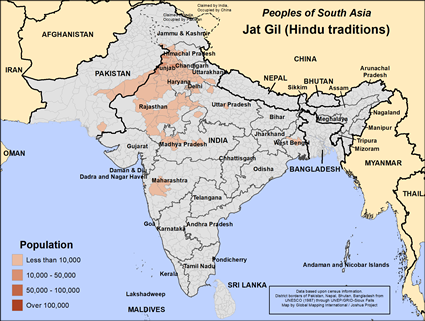There are different opinions as to the origin of the Jats, but most seem to recognize them to be from Indo-Aryan tribes native to the Punjab region that straddles modern Pakistan and India. There is a theory suggesting that they may be the predecessors of Gypsies. They probably reached Egypt with the Muslim conquerors, lived in Afghanistan before the Muslims, and invaded China with the Mongol Army. They also proved to be a threat to Tamarlane in Persia and Uzbekistan in the 1400s.
There are very few records concerning Jats prior to the 1600s. They rose to prominence following the 1669 Jat uprising against Mughal rule, and they ruled various princely states throughout the 18th century. For centuries the Jat lifestyle was designed to foster a martial spirit. Whenever they lost their kingdoms, Jat people became landlords who were ready to defend their land against any invaders.
After 1858, under the British Raj, the Jats were known for their service in the Indian Army, being categorized as a "martial race" by the British. For a couple hundred years Jats were a force that could not be ignored by South Asians or British imperialists.
Gil Jats are among the largest Jat Gotras in South Asia. They can be either Hindu or Muslim in Pakistan.
Gil can refer to either a surname or a clan. The Gil Jat clan is mainly found in the Punjab regions straddling eastern Pakistan and northwestern India. It is one of the largest and most aristocratic of the Jat clans. The Hindus among them are most likely to live in Punjab Province and speak Saraiki.
Overall, Gil Jats have a good self-image. "Men may come and men may go, but I go on forever," is a well-known Jat proverb. They are brave, hardworking people who possess both the desire and ability to rule. It has been said that no Jat wants to be ruled. Rather, he desires to have power over a group if not over an area. They take great pride in their ancestry. In fact, all the Jats in a particular village consider themselves to be the descendants of the man whom they believe founded it by the power of the sword.
Conservative by nature, Hindu Gil Jats rarely marry people from other people groups. From about 1650 AD onwards marrying within same gotra (i.e., lineage or clan) became more common. The modern-day litmus test that Jat people use in marriage is if the girl and boy must not have the same great-great-grandparents (not related for four generations). If they are from the same gotra but are not directly related for four generations then it is considered acceptable for them to marry.
Physically, the Jats are usually taller and heavier than most of their neighbors. Because of their larger build, their reputation for violence, and the fact that they control much of the land and village income, they are generally feared by other communities in South Asia.
Most Gil Jats live in rural areas, and they are usually landowners. A small percentage are traders and laborers. Today, the Jats are well read, and some occupy high positions in academic and technical arenas. Ironically, because they value thriftiness and diligence, the Jats are often regarded as miserly.
Hindu Gil Jats adhere to traditional practices as well as a wide variety of additional beliefs. They might worship one god, many gods, or none at all depending on what they believe will benefit them. They are very pragmatic in their spiritual practices. Regardless of their religious affiliation, Jats observe many ceremonies, especially rites of passage.
Many Hindu Gil Jat communities need clean drinking water and proper health care facilities. Christian medical teams and humanitarian aid workers are needed to work among them and show them God's love in practical ways.
Missionaries, Christian broadcasts, and evangelistic literature are needed to effectively reach Gil Jats with the light of the gospel. Most importantly, they need people who will begin to intercede for them, tearing down the strongholds that are keeping them in spiritual bondage. Only then will their hearts be prepared to receive the good news as it is presented to them.
Pray that Gil Jat people will have a spiritual hunger that will drive them to seek and find Jesus Christ.
Ask the Lord of the harvest to send out laborers filled with the power and the fruit of the Holy Spirit to serve Gil Jats.
Ask God to save key Gil Jat leaders who will begin a disciple making movement among their people in the 2020s.
Pray for Gil Jat leaders to recognize the blessings that Christ offers their families and communities.
Scripture Prayers for the Jat Gil (Hindu traditions) in Pakistan.
https://www.jatland.com/home/Gotras
https://en.wikipedia.org/wiki/Jat_people
https://www.britannica.com/topic/Jat
http://www.dawn.com/news/1077113
https://www.jatland.com/home/Jats
https://www.quora.com/Who-are-the-Jats-and-why-ar
| Profile Source: Joshua Project |











